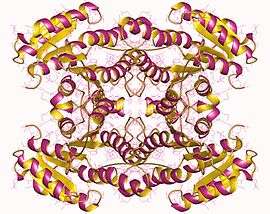Glucose 1-dehydrogenase
In enzymology, a glucose 1-dehydrogenase (EC 1.1.1.47) is an enzyme that catalyzes the chemical reaction
- beta-D-glucose + NAD(P)+ D-glucono-1,5-lactone + NAD(P)H + H+
| glucose 1-dehydrogenase | |||||||||
|---|---|---|---|---|---|---|---|---|---|
 Glucose dehydrogenase tetramer, Caenorhabditis Elegans | |||||||||
| Identifiers | |||||||||
| EC number | 1.1.1.47 | ||||||||
| CAS number | 9028-53-9 | ||||||||
| Databases | |||||||||
| IntEnz | IntEnz view | ||||||||
| BRENDA | BRENDA entry | ||||||||
| ExPASy | NiceZyme view | ||||||||
| KEGG | KEGG entry | ||||||||
| MetaCyc | metabolic pathway | ||||||||
| PRIAM | profile | ||||||||
| PDB structures | RCSB PDB PDBe PDBsum | ||||||||
| Gene Ontology | AmiGO / QuickGO | ||||||||
| |||||||||
The 3 substrates of this enzyme are beta-D-glucose, NAD+, and NADP+, whereas its 4 products are D-glucono-1,5-lactone, NADH, NADPH, and H+.
This enzyme belongs to the family of oxidoreductases, specifically those acting on the CH-OH group of donor with NAD+ or NADP+ as acceptor. The systematic name of this enzyme class is beta-D-glucose:NAD(P)+ 1-oxidoreductase. Another name in common use is D-glucose dehydrogenase (NAD(P)+).
Structural studies
As of late 2007, 9 structures have been solved for this class of enzymes, with PDB accession codes 1G6K, 1GCO, 1GEE, 1RWB, 1SPX, 2B5V, 2B5W, 2CD9, and 2CDA.
gollark: Afternevnooning!
gollark: !time gollark
gollark: What if HelloBoi LITERALLY UTC+8?
gollark: It stands for QED enough done.
gollark: For purposes.
References
- Banauch D, Brümmer W, Ebeling W, Metz H, Rindfrey H, Lang H, Leybold K, Rick W, Staudinger HJ (1975). "[A glucose dehydrogenase for the determination of glucose concentrations in body fluids (author's transl)]". Z. Klin. Chem. Klin. Biochem. 13 (3): 101–7. PMID 810982.
- Brink NG; Miettinen, Jorma K.; Olsen, John; Virtanen, Artturi I.; Sörensen, Nils Andreas (1953). "Beef liver glucose dehydrogenase. 1. Purification and properties". Acta Chem. Scand. 7: 1081–1089. doi:10.3891/acta.chem.scand.07-1081.
- Pauly HE, Pfleiderer G (1976). "D-Glucose dehydrogenase from Bacillus megaterium M 1286: purification, properties and structure". Hoppe-Seyler's Z. Physiol. Chem. 356 (10): 1613–1623. doi:10.1515/bchm2.1975.356.2.1613. PMID 2530.
- Strecker HJ, Korkes S (1952). "Glucose dehydrogenase". J. Biol. Chem. 196 (2): 769–84. PMID 12981017.
- Thompson RE, Carper WR (1970). "Glucose dehydrogenase from pig liver. I. Isolation and purification". Biochim. Biophys. Acta. 198 (3): 397–406. doi:10.1016/0005-2744(70)90118-x. PMID 4392298.
This article is issued from Wikipedia. The text is licensed under Creative Commons - Attribution - Sharealike. Additional terms may apply for the media files.